Ingmars klyv
About a hand-operated woodsplitter that I made.
As I have understood that many people from other countries are interested in my splitter I will try to make an english version of this site.
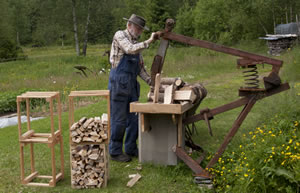
|
Ingmars klyv About a hand-operated woodsplitter that I made. As I have understood that many people from other countries are interested in my splitter I will try to make an english version of this site. |
 |
My name is Ingmar Andersson and I live in the Swedish countryside. About fifteen years ago as well as today I used wood stove for heating and cooking. I had much work with woodsplitting for the kitchen stove and that made me think about a more effective tool than my ordinary ax. I had the following demands at the tool that I was dreaming of: Of course I knew very well that such a contraption was impossible to construct but as I love to build castles in the air I went on fantasize whenever I was splitting wood with my handax. The thinking went so far that eventually I welded an old rusty ax to the end of a heavy iron bar and tried drop it on the end of a log of wood that stood on the ground. In the very moment I saw how the movement of the heavy ax in a fraction of a second transformed to splitting force and almost without braking split the log, the solution of the problem was clear in my mind: I put a shaft to the ax, I fastened the shaft to a joint and I balanced it with an old car spring to suspend the heavy ax "weightless" in the air. In that way I build my first woodsplitter. |
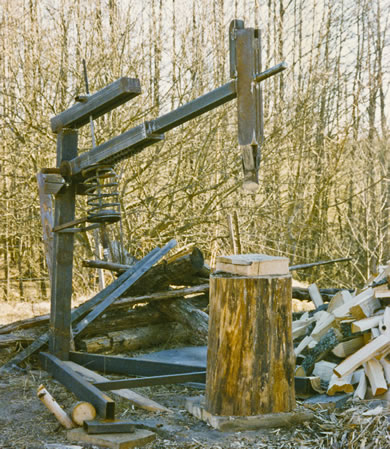 |
||||
There is really something magic with this splitter! I don't feel that I put in as much energi as needed to split the wood but nevertheless the wood is split and that is certainly a wonderful experience! Perhaps you can explain the "missing" energy with the great accuracy of this splitter: you make use of nearly one hundred per cent of the energi you put in and you always hit exactly where you are aiming. I never stop loving to use the splitter! The first splitter was a prototype that I after some years left by my friend Petter when I intended to construct splitter number two. Petter made a YouTube-film with the splitter and he gave it the name Ingmars klyv. The film have many visits and interesting comments. With splitter no 2 I wanted to correct some mistakes and examine some other possibilities, for example to use a pull-spring instead of a compression-spring. So I ordered an expensive spring from a spring-factory and build a splitter for it because I wanted to try the method. That splitter is now in my brother's barn and he use it to make splinters to start the fire with, wich his hydraulic firewood-machine can not do. At that time I considered the pullspring-splitter to be a side-track because the spring is that expensive and because it needs a little more space as the shaft and spring are protruding. Nowadays I think the pull-spring has some advantages over the compression-spring: It gives a simplier construction of joint and spring and you can easier find used springs when you can combine different springs either parallel or serie. |
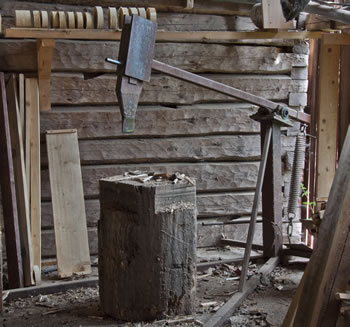 |
||||
After some years living in compartments totally without woodsplitting and thereafter seven years in a house with kitchen-oven when I split all wood with just a hand-ax (wich I also enjoy very much), I now (june 2012) think it's time to build the ultimate splitter. I'm getting older and I very much want to perfect the construction and live using it.
|
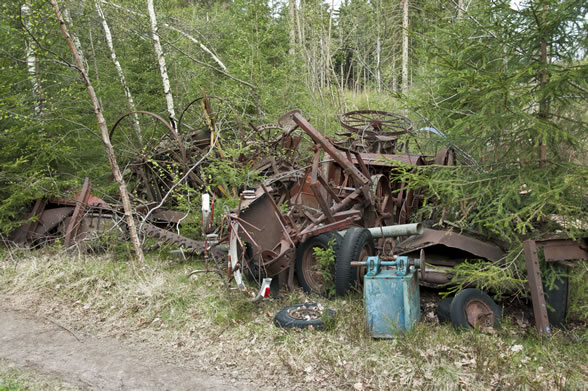 |
||||
I made a simpel scetch of the first splitter in scale 1:10 where I noticed the changes that should be done. The changes were mainly to build the stand into a concrete chopping block, lower the joint a little, make a simplier suspension for the spring and to change the leaning of the ax. Then I just had to cut rusty steel, grind and weld together. The first step was to put the bearing steel girder (75x75x4 mm square tube, from a tractor harrow) in the right height and leaning. I stitch the construction together with MIG-welding and weld otherwise with stud welding wich I think gives a stronger weld-joint. |
 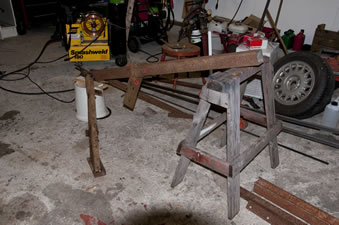 |
||||
| The joint is an important part of the splitter. Here I cut loose a joint from a loggingtractor crane.
|
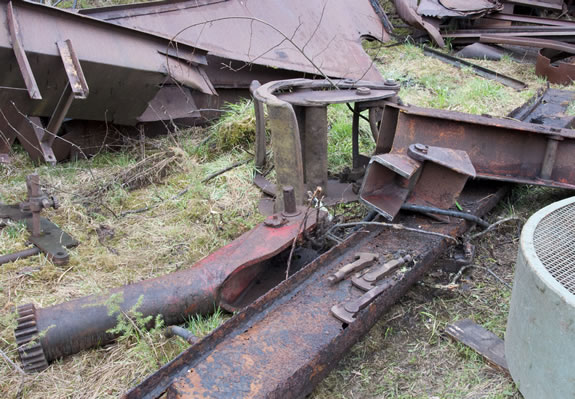 |
||||
The spring that I use comes probably from a Volvo 240. It is 430 mm long when no pressure is on and 290 mm long when the ax is hanging weightless in the air. The diameter of the spring steel is 13 mm and it winds 5 1/3 rounds along the working part of the spring. The outside diameter of the spring is 160 mm. The spring is squeezed between the two planes, one at the shaft and the other at the stand. There is no other fastening and I set the height of the ax by moving the spring (with a level), towards the joint lower the ax and towards the ax raise the ax. There is no need for extra fastening thanks to the broad and very rusty squeezing planes. To make the moving of the spring easy the planes should be more or less parallel when the ax is hanging weightless. To install the spring I simply raise the ax high in the air with a tackle. There are two small steelbits welded to the planes to wich I can hook the spring when installing. The tackle is fastened to the upper end of a loose pole. |
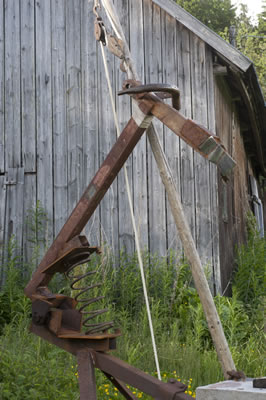 |
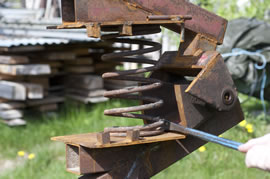 |
|||
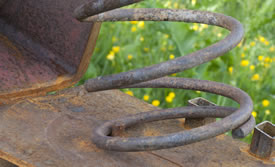 |
|||||
Dimensions By measuring with a ruler in this picture you can learn the dimensions of all visible parts of the splitter. The splitter's ax-shaft is exactly 1280 mm from the rear end to the ax. Divide 1280 by the measurement in millimeter of the shaft in the picture and multiply the result by the measurement of any other part of the splitter in the picture and you have the dimension in millimeter. Unfortunately is the result not always correct depending on the perspectivical distortion. Test your measuring with the height of the spring that is 290 mm. The axshaft is 75x75x4 mm square tube. Maybe a little unnecessarily thick but that is what I had. There can sometimes be tough strain on the shaft and it should not be too weak. The axedge is an old and very rusty axe wich I found in a scrap heap. It was broken by the shafthole and became just the right size when I had cut it clean. I have ground and polished the surfaces wich will touch the wood so it will glide easy and I have ground the outer edge thin but the sharp edge point have I ground dull so I can not cut my skin when I handle wood logs near the edge! I have mostly ground only just where I shall weld. I like the rust color and the original colors of the scrap. The splitter is also a kind of scrap sculpture (functionalism?) but above all: useful.
|
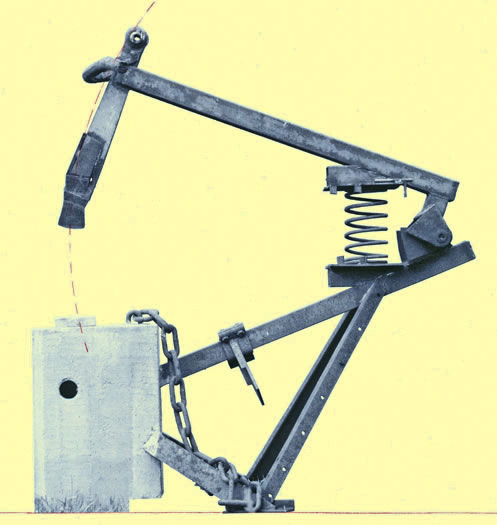 |
||||
I wanted a heavy concrete chopping-block to make the impact hard and rigid. I think this block weighs about 300 kilo. Later I cast a stone in the surface to hit against. More about that further down in the site. The chopping block could preferably have double the weight to make the impact even more rigid but then it must be standing just at the same place for ever. Now I can at least move and turn it a little with the help of a jack. The heavy chain is for hanging the splitter in a tractor front hoe or loading crane. Before hanging it in the chain I take away the spring and let the ax rest low or I simply lock it down with a strap. I also needed a bigger work surface to prevent the splitted logs to fall to the ground. As I am right-handed the table looks like this. For a left-handed person it ought to be the opposit as he will maneuvre the ax with left hand and then the splitted logs will fall mostly to the left. |
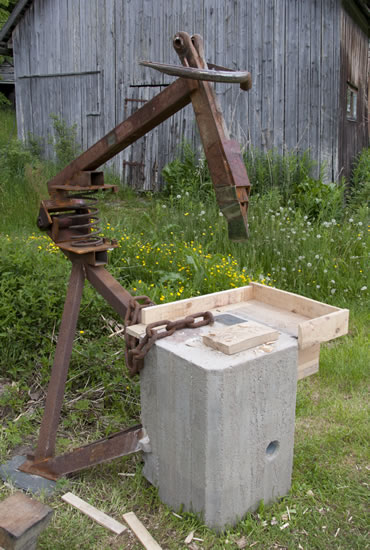 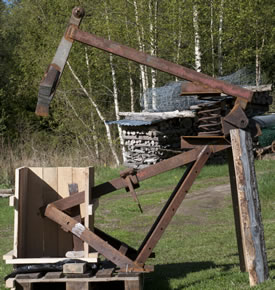 |
||||
Safer than many pople think! As you always know exactly where the ax edge will hit this splitter is much safer than an ordinary ax or a knife. At the picture I make splinters for starting fire in the kitchen stove. With a rubber band around the block the small splinters will not whirl about so much...
|
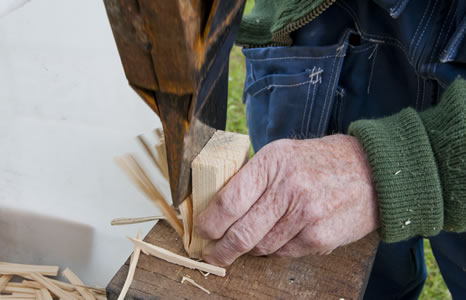 |
||||
Here the concrete is painted three times with copperas to have a colour similar to rust. The rust color faded later slightly, I think because of the rain.
|
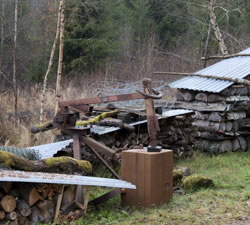 |
||||
| Some Youtube films about this splitter or the same idea: | |||||
| Ingmars klyv (the first prototype that Petter in Gudhem now have) http://www.youtube.com/watch?v=MD0cp3g6O78 | |||||
| russian version https://www.youtube.com/watch?v=vvJvgEridiM | |||||
| Ukraina https://www.youtube.com/watch?v=dGGH4XKNULU | |||||
| Ingmars klyv II http://www.youtube.com/watch?v=Z06XgIz55ec | |||||
| another russian version https://www.youtube.com/watch?v=cSBVoWj6XQQ | |||||
| hungarian advanced model https://www.youtube.com/watch?v=ca7ZPfkcNqA | |||||
| also russian https://www.youtube.com/watch?v=7kDG_oiUjew | |||||
| russian home-made https://www.youtube.com/watch?v=MAEXsXJ0aTY | |||||
| Ingmars klyv III https://www.youtube.com/watch?v=AxjguFuMA5o | |||||
Februari 2015 I have made some important changes at the splitter. The new model is the reddish in the picture. 1. I have made a bend to the axshaft and the ax-head has been shorter and wider and the handle is different. 2. A flat stone is fixed upon the concrete surface to favor the splitting. 3. A stop and a moderating spring prevent the ax-edge to hit the stone. 4. A deadman's grip at the handle release the mechanism that stops the ax swinging.
|
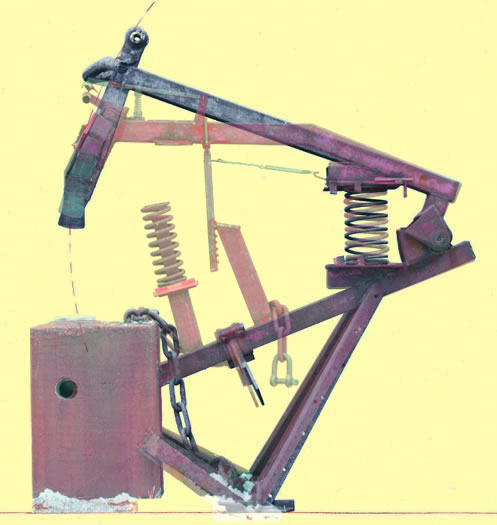 |
||||
I have cut and rearranged the material in the ax to make it more compact. Most of all I wanted to lower the CG in order to eliminate some vibrations when hitting. The weight of the ax (spring taken away) is now ca. 36 kg. Due to the more rigid impact hit aginst the stone the weight does not have to be as high as on the former model that weighted 38 kg. the ax is now a little easier to start moving. Perhaps in the future I will mount an extra weight, about 4 kg, at the backside of the ax, under the shaft. It will be removable and mounted only when I will split a great quantity of big logs. |
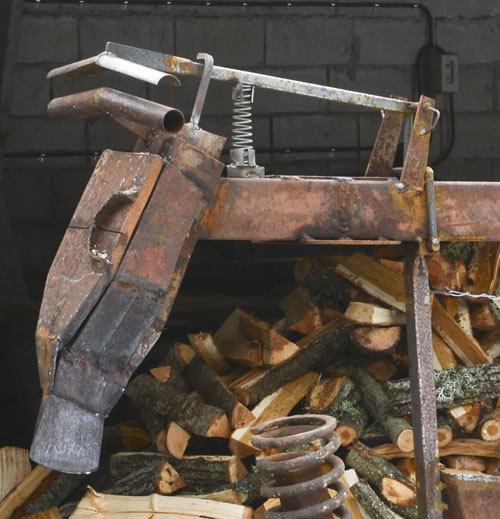 |
||||
The new handle is made of steel-tube, 30 mm diameter, that is fastened to the ax with a flat iron, 5 mm. I think it's very comfortable. A "dead-man's grip" release the suspending mechanism that locks the ax in a high position to prevent injuried fingers from the ax' swinging.
Unfortunately is the original simplicity of the splitter reduced and its is no longer noiseless. But it's safer and more effective and comfortable to work... |
 |
||||
I cut a hole in the concrete and fixed a stone in it with its flat upper side 12 mm over the concrete surface. The visible surface of the stone is 70 x 170 mm that is just the right size for balancing a broad wood-log at. The flat stone favor the splitting as the log's both halves easier can fall outwards and apart.
|
|
||||
In combination with the flat stone I also must have some kind of a stop so the ax-edge cannot hit the stone. Before I always had a wooden piece at the concrete to protect the edge. Now, with no wooden piece, the hit will be much more rigid and effective.
|
|
||||
At first I thought about using a used car bumper and that would have been the best, but I tried to mount a hard car spring to take the hardest impact. That works fine and I think I let it be so. It takes some time to get used to that I can hit as much as I can with both my hands without to be careful not to damage something! That's good! After all these changes I now feel the splitter is complete and it is really something similar to that fantastic instrument that I was fantasizing about when I split my wood with my ordinary ax at an oak chopping-block!
|
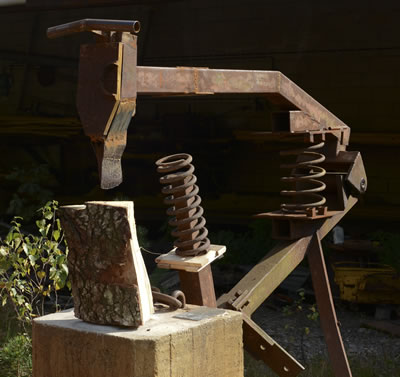 |
||||
ALTERNATIV Ett annat sätt som jag har funderat på vore att ha yxan hängande i en lodrät stång som passerar genom, och vilar på, en stapel bilfjädrar. Då blir yxans rörelse helt rak och yxan kunde t o m vara vridbar och lite mera rörlig, fast jag vet egentligen inte om just det sistnämnda vore någon fördel, en av fördelarna med klyven är ju att man vet precis var yxeggen träffar. Det vore roligt att höra om hur den modellen fungerar ifall någon bygger en sådan. |
|||||
FÖR BYGGARE: Det är viktigt att yxeggen sitter i linje med hela yxans mittlinje och att mittlinjen följer yxans rörelse. Montera först leden och yxskaftet. Därefter bör du rikta in yxans tyngddel (hydraularmarna i mitt fall) genom att nästa fast den vid skaftet och röra den för att kontrollera att båda ändarna följer samma linje när du rör skaftet upp och ner. Därefter sätter du fast själva klyvyxan och riktar in eggen så att den följer samma linje. Om det hela sitter snett kan man få en kraftödande skakning åt sidan vid varje slag. Om leden inte sitter helt exakt vågrätt har inte lika stor betydelse, men den får förstås inte heller vara alltför sned. Jag är inte riktigt klar över hur yxans vinkel mot cirkelbågen som den rör sig i skall vara. Det enda säkra är att det är bäst om tyngdpunkten ligger så nära yxeggen som möjligt. En lång yxa med hög tyngdpunkt förstärker eventuella fel i lutning och vinkel. Jag håller på att fundera på om jag ska gjuta på tio centimeter på betongklumpens framsida. Den skakar lite när jag dänger i stora kubbar och möjligen blir det bättre om slaget träffar mer i mitten av klumpen. Som det är nu så träffar det närmare framkanten och jag ska nu prova ut om det fortfarande är plats att stå om betongen kommer tio centimeter närmare benen. Dessutom är en större tyngd alltid bra, utom när den ska flyttas. |
|||||